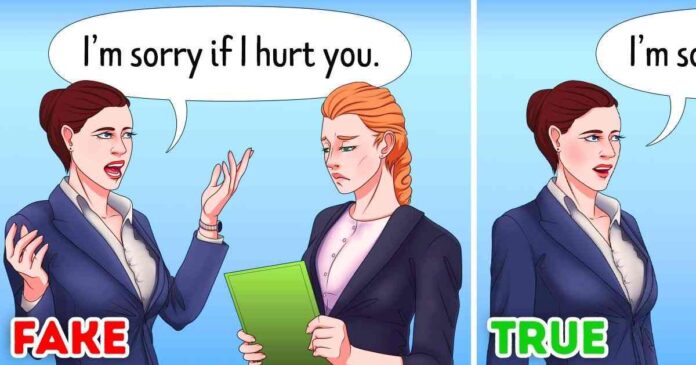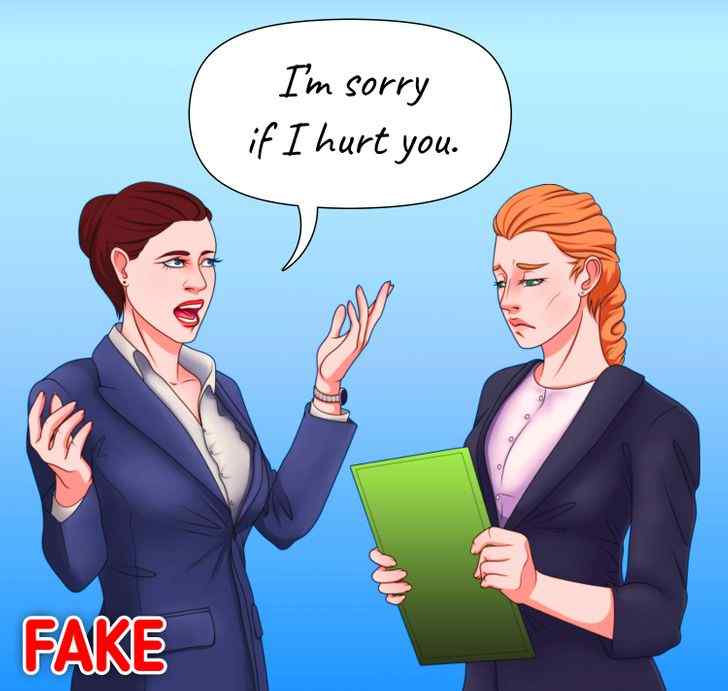
Apologizing can be difficult. It can be as painful as a splitting headache for some people to say “I’m sorry”. But it can also be done insincerely by those of us who manage to pluck up their nerve and apologize. Fake apologies are so popular, it turns out, that we have plenty of words to name them: an apology for non-apology, non-apology, backhanded apology, or even fauxpology.
1. A fake apology contains an “if” or a “but.”

And if the apology includes the actual words “I’m sorry” but is then continued with an “if” or a “but,” according to psychologists, it is not something that sounds real. In fact, a “but” invalidates the apology, while an “if” implies that you might not have happened whatever hurt you. On the contrary, a sincere apology places all the blame on the individual who offers this apology and does not diminish the feelings of the hurt person.
2. A fake apology is too wordy.

Actually, an apology that comes from your heart does not need many words. On the other hand, a fake apology provides a whole bunch of needless excuses and information that attempt to mask the true feelings of the individual about the situation.
3. An insincere apology contains a passive voice.
An expression such as “the things you were affected by” or something similar will normally contain this sort of fauxpology. In public speaking, the wording “mistakes were made” is frequently used when the speaker acknowledges that something wrong has been done, but simply tries to escape direct blame by preferring to speak in a passive voice.
The passive voice phrases do not say who is directly responsible for the situation, while the subject of the action (“I made the error”) is stated by an active voice phrase.
4. A true apology cannot start with, “They told me to apologize.”

Actually, when a person uses these terms, they mean that apologizing to you does not come directly from them. This apology is given only because someone else thinks that this is important, and otherwise this person would not apologize.
5. “You know I…”, “I already have…” and some other tricky terms are what people say when they try to apologize without actually apologizing.

Expert Dan Neuharth, Ph.D., MFT, addresses a variety of phrases that can be regarded as fake apology red flags, and here are some of them:
- “You know I…” Honestly, this wording is trying to persuade you there’s nothing to be mad about. (“You know that I didn’t mean that.”)
- “I already have…” This sentence means that there is nothing else to say and nothing more to apologize for. (‘I have apologized many times already for that.’)
- What this phrase does is shift the blame on you and make you the root of the issue.” I’m sorry you…” (‘I’m sorry you’re feeling that way.’)
- “I guess I…” This just indicates the need to apologize, but it still does not offer an apology. (‘I should apologize, I guess.’)
- And, of course, ‘I’m sorry, all right! The expert calls this a “bullying apology” that neither in its vocabulary nor in its tone really sounds like an apology.
6. A fake apology is not followed by an action.

When trying to apologize, whatever the individual says, the important thing about a sincere apology is the action behind it. This behavior is aimed at compensating for the pain you feel and means trying the first time to fix what was done wrong. It means putting into action terms. Making sure that this will never happen again is another important thing. This is what makes a person a “trustworthy apology”
Can you use these tips when anyone gives you an apology next time? Do you have hacks of your own as to how to say whether a person is truthful or lying? In the comments, share your tricks!
